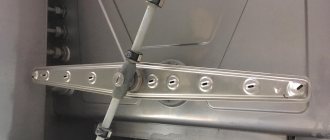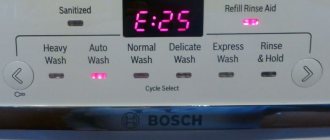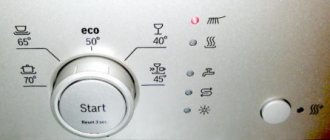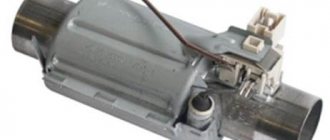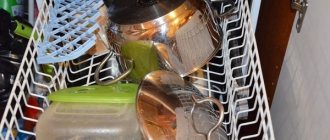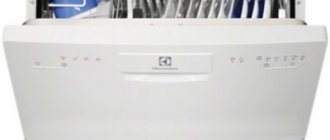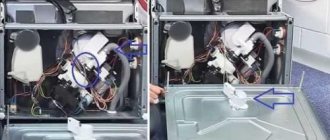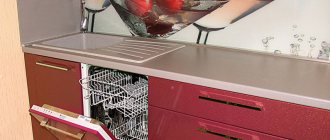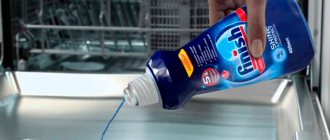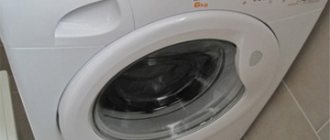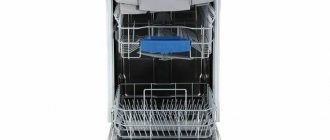Do-it-yourself repair of Bosch dishwashers. Dishwasher device
| 1 | basket | 12. circulation pump |
| 2 | door spring | 13. capacitor |
| 3 | impeller | 14. Rinse aid dispenser |
| 4 | thermostat | 15. lock |
| 5 | filters | 16. detergent dispenser |
| 6 | drain hose | 17. valve |
| 7 | pressure meter | 18. door seal |
| 8 | drain pump | 19. lid of the container for regenerating salt |
| 9 | water intake | 20. heating element |
| 10 | Leak and overflow protection device | 21. water filling hose |
| 11 | programmer or control module | 22. guide roller |
Do-it-yourself dishwasher repair. The structure of dishwashers, regardless of the manufacturer and its model, can be represented by a single diagram
The main functions that the dishwasher performs after pressing the start button and closing the door are:
- Draining water (usually at the start of any selected program).
- Filling of water.
- Start of the washing process.
- Adding detergent (added at the stage of loading dishes).
- Heating water.
- Washing process (takes time depending on the washing program you choose).
- Draining.
- Filling with water for rinsing.
- Rinsing.
- Draining.
- Drying.
Eleven main functions are responsible for high-quality dishwashing. Eleven main functions are performed by functional units (parts, devices, peripheral devices) of dishwashers.
The sequence of turning on/off the peripheral devices of the dishwasher is controlled by the electronic control module (hereinafter referred to as the processor)
The washing programs differ:
- time (duration of execution).
- degree of water heating (from 50 °C to 75 °C).
- the presence or absence of a pre-soaking function.
Prices for repairing Bosch dishwashers at home
| Name of service | Price |
| Visit of the master | For free |
| Diagnostics in case of repair | For free |
| Replacing the door seal | from 400 rub. |
| Cleaning the drain system | from 600 rub. |
| Cleaning the circulation system | from 600 rub. |
| Repairing water leaks | from 500 rub. |
| Installing a new dishwasher | from 800 rub. |
| Replacing the drain pump | from 600 rub. |
| Recirculation pump repair | from 300 rub. |
| Replacing the Recirculation Pump | from 600 rub. |
| Replacing the heating element | from 500 rub. |
| Replacing the fill valve | from 400 rub. |
| Replacing the drain hose | from 500 rub. |
| Electronic module repair | from 800 rub. |
| Replacing the door hinge | from 300 rub. |
| Replacing pipes | from 400 rub. |
| A technician will visit you for in-depth diagnostics without repairs. | 1500 rub. |
| In case of refusal to repair, the departure is paid by the customer in the amount of | 500 rub. |
Call a specialist
Consultation and calling a specialist: 8 (495) 142-34-70. Call!
Repair of Electrolux dishwashers. Repair of ELECTROLUX dishwashers
No surcharges for urgency
Dishwasher not working?
To order repair of Electrolux dishwashers, just one phone call is enough. In most cases, breakdowns are repaired on the same day they occur. The sooner the owner of the equipment submits an application, the better. The wizard will quickly help if:
- the unit has stopped responding to entered commands;
- due to corrosion, damage to metal parts occurred;
- water drains or fills too slowly;
- The dishes remain dirty after washing.
There can be a lot of possible breakdowns, even though Electrolux equipment is considered one of the most reliable on the market. Spare parts and components tend to wear out, voltage surges and lack of maintenance are also serious enemies of equipment such as dishwashers.
Are there rules for connecting a dishwasher to the electrical outlet?
The voltage and type of power supply to the machine must correspond to the local power supply. The manufacturer is not responsible if this point is not fulfilled. The outlet must be electrically safe and properly installed. It is better not to use extension cords, adapters and various connectors. A mandatory step when cleaning equipment or performing maintenance is to disconnect the device from the power supply.
How to properly connect the machine to the water supply?
The inlet hose can be connected to the cold and hot water pipeline, but in the second case there is a limitation - the water temperature should not exceed 60 degrees. Most often, the hose is attached to a water valve with a 3/4″ male thread; it should not be bent or crushed. To protect against water leakage, you need to tighten the locknut correctly; there is also a special safety valve for this purpose.
Why do dishes remain dirty after washing?
If, after completing the washing process, the contents of the machine remain dirty, it is advisable to contact a specialist. There may be several reasons for this problem: clogged or incorrectly installed filters, broken sprinklers, or a software failure. Also, the program may not be suitable for a specific type of dish and degree of soiling, and sometimes the baskets are simply loaded incorrectly.
Why does limescale remain on dishes?
To identify the exact cause of the formation of limescale, you will need to diagnose your dishwasher. But the main problems may be the following: lack of salt in a special container, an incorrectly screwed lid of this container, failure to adjust the water softening level. It is advisable to eliminate the problem as early as possible, because washing and rinsing dishes additionally each time is both time-consuming and more expensive.
What to do if there is no water coming into the dishwasher?
Most often, water flows poorly or does not enter the dishwasher at all due to a clogged water valve or an overly dirty filter in the inlet hose. This problem also occurs when the hose is bent or squashed. There may also be a connection error. An experienced specialist will diagnose the equipment, its individual systems, components and help resolve the problem.
When should you clean the filters in your dishwasher?
In most cases, Electrolux dishwashers are equipped with three types of filters: coarse filter, microfilter and flat filter. If washing efficiency noticeably decreases and dishes remain dirty, it's time to clean the filters. Filter systems can be easily removed and washed under running water. Next, they need to be inserted into place and securely fixed.
What is the Multitab function and what is it for?
The main task of the Multitab function is the combined use of detergent in the form of tablets, which additionally include rinse aid and special salt. The indicator monitors the need to add salt and rinse aid, stops and resumes supply when required. When using the Multitab function, dishwashing times may increase.
What are the best detergents to use?
It is recommended to use only detergents that are designed for dishwashers. They come in liquid, powder and tablet form. Manufacturer's recommendations for dosage and storage should be followed. The product is poured into a special dispenser. If you exceed the amount of detergent, a lot of foam will form and the washing process will be poor.
Are there any rules for loading dishes and cutlery?
Do not place items that absorb water or glassware that is too thin into the dishwasher. Before placing cutlery and dishes inside the machine, you need to remove any remaining food and soften burnt food. It is recommended to place hollow items upside down; small items should be placed in a separate basket. When washing glasses, they should be placed so that they do not touch each other.
Why use additional rinse aid?
The dishwasher has a special dispenser for placing rinse aid in it. It is designed to dry dishes without stains, streaks or streaks. The owner of the equipment only needs to monitor the amount of rinse aid in the compartment, and the machine itself will add it in the required volume during the last rinse aid cycle. If there is some water in the rinse aid reservoir, this is not a problem.
Bosch dishwasher repair. Bosch dishwasher repair
No surcharges for urgency
Dishwasher not working?
It is better to order repair of Bosch dishwashers as soon as problems arise in the operation of the equipment. Breakdowns can be caused by power surges, low-quality water with impurities, direct exposure to sunlight on the body and individual parts, violation of basic operating rules, and wear of components. Calling a specialist is relevant when:
- lack of power supply and equipment response to commands;
- interruption of the dishwashing cycle or malfunction of the control panel;
- problems with fill or drain valves, damaged hoses;
- corrosive effects on metal components and parts.
In order for the problem to be resolved quickly and effectively, professional diagnostics are required. A guarantee of success in repairs is the use of original spare parts and components, high-quality consumables.
Are all dishes dishwasher safe?
Sometimes dishwasher breakdowns occur due to improper operation of the equipment, namely due to violation of recommendations for the type of content. The manufacturer Bosch does not recommend washing knives, fragile glass, wooden objects, anodized dishes, or thin plastic that can become deformed due to exposure to high temperatures.
What are the most popular dishwasher operating modes?
This type of equipment can operate in economical mode, reducing energy costs by up to 20%. You can choose accelerated dishwashing, in which the standard cycle goes much faster. Also available are modes such as hot and cold, rinsing, drying, working with delicate items, enhanced washing, half load. If any of the functions does not work, you need to contact a technician.
What temperature mode should you choose for washing dishes?
The choice of temperature depends on the type of contents in the dishwasher and the degree of soiling of the dishes. For example, for washing thin glass items, plates and mugs, it is better to choose a water temperature of 45...55 °C. For cleaning frying pans, pots and overly dirty dishes, an intensive washing mode at a water temperature of 65...75 ° C is more suitable. If the stated temperature conditions are violated, equipment repair will most likely be required.
What should I do if I hear increased noise when the machine is running?
Most modern models of Bosch dishwashers operate almost silently (in the range of up to 45 dB). Noise levels are significantly reduced through the use of modern materials and technologies. Noise may increase when individual parts are worn or damaged. It is possible to determine the true cause of discomfort as a result of professional diagnostics.
Do Bosch dishwashers have their own error codes?
Yes, if certain malfunctions appear on the control panel of your Bosch dishwasher, you will see special error codes. For example, E1 indicates a water heating problem, E2 indicates a temperature sensor error, E3 indicates difficulty filling the tank with water, E4 indicates a problem with the water flow switch, E5 indicates the fill level has been exceeded due to a faulty water level switch or inlet valve. There are many other error codes.
Why doesn't the water drain from the machine?
Most often, this problem occurs due to a blockage of the pump responsible for draining water from the dishwasher tank. Also, a foreign object or contaminant may get into the impeller and clog the system. The absence of blockage indicates possible wear of one of the pump elements. Removal of blockages and replacement of components must be carried out by a qualified specialist.
Unauthorized water collection has started, what should I do?
This is most likely caused by a problem with the inlet valve or water flow sensor. It would be a good idea to check the condition of the water level sensor. Another common cause is excessive foaming due to overuse of detergent. It is impossible to cope with each of the listed problems on your own; the intervention of a specialist is important here.
What is an aquasensor used for?
The main task of the aquasensor is to monitor the state of water at the stage of initial rinsing of dishes. This element takes into account such water characteristics as hardness, turbidity, and level of pollution. If the dishes are not too dirty, the system eliminates the hot rinse process, thereby reducing water and electricity consumption. If a failure occurs in the operation of the aquasensor, it is necessary to carry out diagnostics and restoration.
What causes problems with filling your dishwasher with water?
Depending on the selected mode, the system gives a certain period of time to fill the tank with water. If difficulties arise during the flow of water, there may be several reasons: mechanical damage or blockage of the main hose, breakdown of the pump or inlet valve, failure of the pressure switch. An experienced technician only needs a few minutes of diagnostics to understand what’s wrong.
How quickly will the technician arrive when called?
The workshop provides professional repair services in Moscow, minimizing customer waiting time. The specialist leaves at the specified address on the day of the request, even urgently if necessary. The dispatch service processes the application in a matter of minutes, coordinates the main issues and sends a technician to repair the equipment. In most cases, the restoration work itself lasts about an hour.
Typical Bosch dishwasher problems
Below are possible signs of a dishwasher malfunction and approximate repair prices.
| Manifestation of malfunction | Possible causes and solutions | Cost in rubles (from) |
| Dishwasher won't turn on | 1. Check the voltage in the network or outlet. 2. The dishwasher power filter has failed. 3. The PM electronic module is faulty. | 600 rub. |
| The program does not start | 1. The car door is not closed tightly. 2. The dishwasher door lock is faulty. | 600 rub. |
| Doesn't take up water | 1. The water supply tap is closed. 2. Low water pressure in the system or the water is turned off. 3. Malfunction of the PM water supply valve. | 600 rub. |
| Leaking or leaking | 1. Check the water supply and drain hoses for leaks. 2. If there is a leak from under the car, look for the source and check the tightness of the connections. | 600 rub. |
| Doesn't heat water | 1. The heating element (heating element) has failed. 2. Temperature sensor malfunction. 3. No voltage is supplied to the heating element from the electronic PM module. | 800 rub. |
| Stops during a cycle | 1. For some reason the dishwasher was unable to drain the water. 2. There is no water heating. 3. The electronic module may be faulty. | 800 rub. |
| Doesn't drain water | 1. Check that there is no blockage in the drain filter, pipes and hose. 2. Check the functionality of the drain pump itself. Otherwise, the pump must be replaced. 4. The defect may also be associated with a malfunction of the control module. | 800 rub. |
| Makes strange noises | 1. Ingress of foreign objects (food debris or glass fragments). 2. Wear of the recirculation pump. 3. Worn or damaged drain pump. | 800 rub. |
| Gives an error message | 1. Electronic failure during the wash cycle. 2. Call a technician and reprogram the electronic module. | 1000 rub. |
This is not a complete list of faults; if you haven’t found your fault, call or fill out an online order.
The table shows the lower threshold for the cost of repairing dishwashers. The technician will determine the exact cost of repairs after performing diagnostic work.
Flexible discount system
Dear Our customers, I am ready to offer you an excellent system of discounts, which is aimed at reducing the cost of repair work.
Get a discount
Video reviews
See all
Dishwasher repair. Water leak
Some dishwasher problems are caused by water leaks. Then the dishwasher stops during operation and no longer responds to commands. One of the combinations also lights up, signaling a breakdown, but each manufacturer and even each model has its own. But the result is the same - during the washing process (no matter at what stage), the car stops and no longer responds to any signals. Sometimes it can be started again. But after turning it on, it stops again.
The fact is that there is a leakage protection sensor in the pan - it is a polystyrene float. When water appears in the pan, it rises and a contact closes, which is perceived as an emergency signal. Everything is logical - if water appears in the pan, then something is going wrong. This float prevents flooding of your apartment and neighbors below.
Here are the possible causes of PMM water leaks:
- The dishwasher is not level and water is overflowing over the edge of the reservoir.
- Using too much detergent resulted in a lot of foam. Also, do not use a product that is not intended for dishwashers.
- The machine takes in too much water - problems with the water level sensor. During the washing process, open the machine door and make sure that water does not overflow. If there is too much, replace the sensor.
Polystyrene float - leakage sensor
- The rubber door seal is damaged (lost elasticity) or the door does not adhere to the body. This breakdown is easy to track - condensation forms on the underside of the countertop. Sometimes you can see steam escaping during washing. The solution to the problem is to adjust the door hinges or replace the seal.
- Problems with the leak sensor. The same polystyrene float rose up and did not fall down. The contact is always closed. Try to force it down or up. Perhaps the return spring has weakened/jumped off. The solution is to replace the float.
Basic malfunctions and their elimination
Next, we list the most common defects and tell you how you can eliminate them by doing the repairs yourself. Many of them are associated with external factors, for example, low water pressure in pipes or insufficient voltage in the electrical network. Many malfunctions are associated with blockages in the drainage or drainage system of the PMM. This kind of problem is quite easy to fix on your own.
Dishwasher won't turn on
If such an event occurs, the first thing that comes to mind is that there is no supply voltage . This can happen for various reasons:
- the power cord is not plugged into the outlet or is damaged;
- no contact in the 220 V socket;
- the PMM input network filter has failed;
- The electronic control unit (hereinafter also referred to as ECU) is damaged.
A multimeter is a device that helps check the presence of supply voltage
In order to perform diagnostics and check the presence of supply voltage, the user will need a multimeter (hereinafter also referred to as a tester). This device is universal and can be used in the household for various equipment problems.
Damage to the power cord can lead not only to the shutdown of the PMM, but also to a fire.
The tester will allow you to determine whether there is voltage in the socket, and also check the wiring inside the PMM housing for a break. The surge protector may burn out due to excess voltage in the electrical network. A sign of damage is the presence of burnt elements.
In addition to the filter, a starting capacitor installed on the drain pump can prevent the dishwasher from turning on. The serviceability of the capacitor can also be checked with a multimeter by measuring its resistance. Damaged parts must be replaced with strictly similar ones: you should not experiment with the capacitance and permissible voltage of capacitors.
Damage to the ECU is less likely; such a breakdown is complex and requires qualified intervention. In addition to the above reasons, the source of the problem may be the lack of water in the water supply and the door not being closed until it clicks - in these cases, the operating program does not start.
The dishwasher is leaking
Water leakage in the bottom of the PMM is a fairly common malfunction that can lead to flooding of the room. Therefore, recently, almost all manufacturers have equipped their dishwashers with Aquastop protective systems (hereinafter also referred to as “Aquastop”).
Float and sensor of the Aquastop system located in the bottom of the dishwasher
When water penetrates the bottom of the PMM, it lifts the polystyrene float. He begins to put pressure on the sensor, which triggers and sends a signal to shut off the water. The machine stops working, the liquid at the inlet is blocked by a solenoid valve built into the inlet hose. At the same time, the drain pump starts, which pumps water out of the dishwasher. The display shows an error code, which makes it easy to identify the malfunction.
Aquastop solenoid valve at the inlet hose
There can be several reasons for a leak:
- During installation, the dishwasher was not leveled, so the water overflows over the edge of the tank;
- due to poor-quality detergent or its overdose, excessive foaming is observed;
- the water level sensor (hereinafter also referred to as the pressure switch) is faulty, causing the machine to draw too much liquid;
- the seal of the door is broken due to loss of elasticity of the seal or its loose fit to the body;
- The Aquastop system sensor is faulty or the float is stuck.
Eliminating the above problems, with the exception of replacing the pressure switch and the sensor with a float, is quite simple. The condition of the door and excessive foaming are visible to the naked eye; setting the PMM level is also not difficult. In these cases, it is enough to eliminate the cause, remove the water from the pan, dry the machine, and it will be ready for use again.
In addition to the reasons listed, there is a possibility of a leak in the connection of one of the pipes located in the machine body. Read more about leaks and their elimination here.
From this video, readers can learn what to do if your dishwasher is leaking:
Water does not drain
In this case, you can also fix the dishwasher yourself. Problems with the drainage system can occur for several reasons:
- there is a blockage in the drain hose or it is simply pinched;
- sewer clogged;
- the filter element is clogged because it has not been cleaned for a long time;
- The drain pump does not work.
Owners can solve problems with sewerage themselves or call plumbers for this. The filter must be removed and washed thoroughly in warm water and dishwashing detergent to remove grease from the fine mesh.
Removing the filter from its slot for cleaning
You can check the drain pump impeller for free rotation without disassembling the machine body. Access to it will open if you unscrew the hexagon socket screw (TORX) in the glass under the filter and remove the protective cap. You can then check the rotation with your fingers and remove the foreign object with tweezers if it is interfering with the pump.
Disconnecting the drain hose from the diagnostic pump
To diagnose the drain hose for blockages, you will have to disassemble the dishwasher body to get to its bottom. Otherwise, it cannot be separated from the drain pump. Read more about problems with drainage in PMM here. In addition, readers can watch a video that answers the question of how to unblock the drain pump of a Bosch dishwasher:
Water flows poorly or does not flow at all
This kind of defect is associated with insufficient water pressure or clogging in the PMM inlet filters. The malfunction may be accompanied by poor rinsing. To troubleshoot malfunctions, remove and clean the strainers at the inlet hose inlet and at its connection to the dishwasher body.
Coarse filter in the inlet fitting of the dishwasher housing
The Aquastop solenoid valve at the inlet hose may be faulty. To determine serviceability, it is enough to check the resistance of its winding with a multimeter. If the device shows an open circuit, the valve must be replaced. A working valve should have a resistance of 1.5 to 5 kOhm.
In addition, the intake valve in the PMM itself, which is controlled by the ECU, may fail. Also, the cause of poor fluid collection may be improper operation of the pressure switch, giving incorrect readings about its level.
Filter at the inlet of the Aquastop solenoid valve
From this video, readers will learn how to find out the reason for the lack of water supply:
Poor dishwashing quality
In this case, you need to pay attention to whether you are operating the dishwasher correctly. Most often, it is this factor that affects the quality of washing kitchen utensils. For example, not enough washing gel or powder is loaded, dishes are not placed in baskets correctly.
Incorrect placement of dishes is one of the main reasons for poor washing quality
Another probable reason is the formation of scale on the electric water heater. As a result, the liquid does not heat up to the required temperature, which prevents the proper cleaning of kitchen equipment from dirt and food debris. How to clean PMM and its parts from scale, read here.
The nozzles in the sprinkler rocker arms must be cleaned regularly
Another probable reason for poor washing is contamination of the holes in the rocker arms of the sprayers (nozzles). To clean them, you need to remove the lower and upper sprinklers from the chamber and clean their holes with a toothpick, picking out the dirt out.
In many cases, you can diagnose and repair a dishwasher yourself. It is worth calling a specialist in difficult situations when your own strength has been exhausted. Readers can find more detailed information about all common PMM malfunctions on our website.
How to remove a dishwasher tray. Getting ready for disassembly
In a Bosch dishwasher, as in machines of other brands, all the most important parts are located in its lower part. At first glance, it seems that there is nothing difficult in turning the car upside down, removing the pan and gaining access to everything that is required. In fact, in practice everything looks a little more complicated, but more on that later, first, preparation.
In any business, preparation is the basis of all work; approximately half of all failures are the result of a poorly prepared workplace, tools and materials, as well as a lack of necessary information. To avoid getting into trouble, let's start preparing the workplace. Naturally, few people have a full-fledged workshop at home; if you have one, good; if not, it doesn’t matter either. Do the following.
- Slide the Bosch, Siemens (or other brand) dishwasher out of the niche in the kitchen unit, then turn off the water supply and unplug the power cord.
- Disconnect the inlet hose as well as the sewer hose.
- In a convenient place for work, spread cellophane, a few rags on top, and place the dishwasher on them.
Note! Some people find it more convenient to disassemble the Bosch dishwasher in the bathroom so that water leaking from the machine does not flood the floor. If you have a spacious bathroom, you can try this trick.
The “dishwasher” is ready for disassembly. Now let's prepare the tool. Let us note right away that the dishwasher can be disassembled with almost bare hands, the maximum that we need is this:
- Phillips and flat head screwdriver;
- pliers;
- thin awl.
To carry out repairs, you may need another tool, for example, a multimeter, tweezers, a soldering iron, side cutters, an adjustable wrench, but this is a separate story for a separate article.
How does a “dishwasher” work?
Perhaps we are repeating common truths in vain, but I think it will not be superfluous. In order to properly disassemble and then reassemble a Bosch (or other brand) “dishwasher”, you need to have at least a superficial understanding of its structure and how the dishwasher works. In general terms, the structure of the dishwasher is shown in the picture below; in general, this will be enough for you to conduct a quality analysis.
Dishwasher prevention. How often should you wash your dishwasher?
Prevention is the key to stable operation of equipment. If you do not take care of it, accelerated scale formation, the appearance of unpleasant odors, and premature wear are possible. Recommended care schedule:
- After each wash, wipe the sealing rubber and the inner surface of the chamber with a dry cloth.
- Wipe down the control panel and door weekly with a damp sponge and soapy water. The filter also needs to be washed with water.
- Have a monthly “bath day” using citric acid.
Women are especially welcome to work as a dishwasher. Housewives love to cook and treat their family to pickles, but then they have to sort out mountains of dirty dishes. Men are unpretentious eaters and are not inclined to use extra plates, so for them a dishwasher is an ordinary kitchen device, and not a panacea for routine. So it is women who sound the alarm more often than others when using this technique. Having received an assistant at their disposal, the ladies are in no hurry to understand its structure - pump, hose, drain... Phew, how uninteresting! Therefore, any breakdown becomes for them:
- a - surprise;
- b - a disaster.
There are many ways to solve and even prevent possible problems. The secret to success lies in regularly washing the internal surfaces and cleaning the filters.
